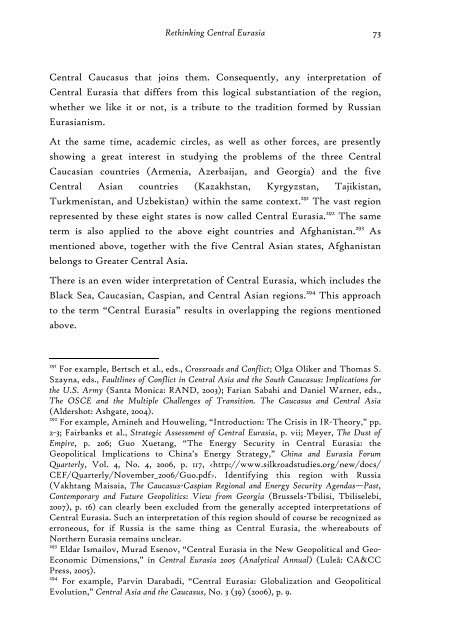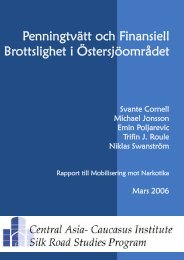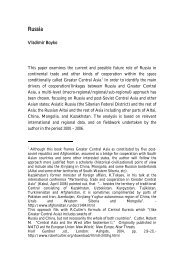Eurasianism and the Concept of Central Caucaso-Asia
Eurasianism and the Concept of Central Caucaso-Asia
Eurasianism and the Concept of Central Caucaso-Asia
Create successful ePaper yourself
Turn your PDF publications into a flip-book with our unique Google optimized e-Paper software.
Rethinking <strong>Central</strong> Eurasia 73<br />
<strong>Central</strong> Caucasus that joins <strong>the</strong>m. Consequently, any interpretation <strong>of</strong><br />
<strong>Central</strong> Eurasia that differs from this logical substantiation <strong>of</strong> <strong>the</strong> region,<br />
whe<strong>the</strong>r we like it or not, is a tribute to <strong>the</strong> tradition formed by Russian<br />
<strong>Eurasianism</strong>.<br />
At <strong>the</strong> same time, academic circles, as well as o<strong>the</strong>r forces, are presently<br />
showing a great interest in studying <strong>the</strong> problems <strong>of</strong> <strong>the</strong> three <strong>Central</strong><br />
Caucasian countries (Armenia, Azerbaijan, <strong>and</strong> Georgia) <strong>and</strong> <strong>the</strong> five<br />
<strong>Central</strong> <strong>Asia</strong>n countries (Kazakhstan, Kyrgyzstan, Tajikistan,<br />
Turkmenistan, <strong>and</strong> Uzbekistan) within <strong>the</strong> same context. 291 The vast region<br />
represented by <strong>the</strong>se eight states is now called <strong>Central</strong> Eurasia. 292 The same<br />
term is also applied to <strong>the</strong> above eight countries <strong>and</strong> Afghanistan. 293 As<br />
mentioned above, toge<strong>the</strong>r with <strong>the</strong> five <strong>Central</strong> <strong>Asia</strong>n states, Afghanistan<br />
belongs to Greater <strong>Central</strong> <strong>Asia</strong>.<br />
There is an even wider interpretation <strong>of</strong> <strong>Central</strong> Eurasia, which includes <strong>the</strong><br />
Black Sea, Caucasian, Caspian, <strong>and</strong> <strong>Central</strong> <strong>Asia</strong>n regions. 294 This approach<br />
to <strong>the</strong> term “<strong>Central</strong> Eurasia” results in overlapping <strong>the</strong> regions mentioned<br />
above.<br />
291 For example, Bertsch et al., eds., Crossroads <strong>and</strong> Conflict; Olga Oliker <strong>and</strong> Thomas S.<br />
Szayna, eds., Faultlines <strong>of</strong> Conflict in <strong>Central</strong> <strong>Asia</strong> <strong>and</strong> <strong>the</strong> South Caucasus: Implications for<br />
<strong>the</strong> U.S. Army (Santa Monica: RAND, 2003); Farian Sabahi <strong>and</strong> Daniel Warner, eds.,<br />
The OSCE <strong>and</strong> <strong>the</strong> Multiple Challenges <strong>of</strong> Transition. The Caucasus <strong>and</strong> <strong>Central</strong> <strong>Asia</strong><br />
(Aldershot: Ashgate, 2004).<br />
292 For example, Amineh <strong>and</strong> Houweling, “Introduction: The Crisis in IR-Theory,” pp.<br />
2-3; Fairbanks et al., Strategic Assessment <strong>of</strong> <strong>Central</strong> Eurasia, p. vii; Meyer, The Dust <strong>of</strong><br />
Empire, p. 206; Guo Xuetang, “The Energy Security in <strong>Central</strong> Eurasia: <strong>the</strong><br />
Geopolitical Implications to China’s Energy Strategy,” China <strong>and</strong> Eurasia Forum<br />
Quarterly, Vol. 4, No. 4, 2006, p. 117, . Identifying this region with Russia<br />
(Vakhtang Maisaia, The Caucasus-Caspian Regional <strong>and</strong> Energy Security Agendas—Past,<br />
Contemporary <strong>and</strong> Future Geopolitics: View from Georgia (Brussels-Tbilisi, Tbiliselebi,<br />
2007), p. 16) can clearly been excluded from <strong>the</strong> generally accepted interpretations <strong>of</strong><br />
<strong>Central</strong> Eurasia. Such an interpretation <strong>of</strong> this region should <strong>of</strong> course be recognized as<br />
erroneous, for if Russia is <strong>the</strong> same thing as <strong>Central</strong> Eurasia, <strong>the</strong> whereabouts <strong>of</strong><br />
Nor<strong>the</strong>rn Eurasia remains unclear.<br />
293 Eldar Ismailov, Murad Esenov, “<strong>Central</strong> Eurasia in <strong>the</strong> New Geopolitical <strong>and</strong> Geo-<br />
Economic Dimensions,” in <strong>Central</strong> Eurasia 2005 (Analytical Annual) (Luleå: CA&CC<br />
Press, 2005).<br />
294 For example, Parvin Darabadi, “<strong>Central</strong> Eurasia: Globalization <strong>and</strong> Geopolitical<br />
Evolution,” <strong>Central</strong> <strong>Asia</strong> <strong>and</strong> <strong>the</strong> Caucasus, No. 3 (39) (2006), p. 9.






